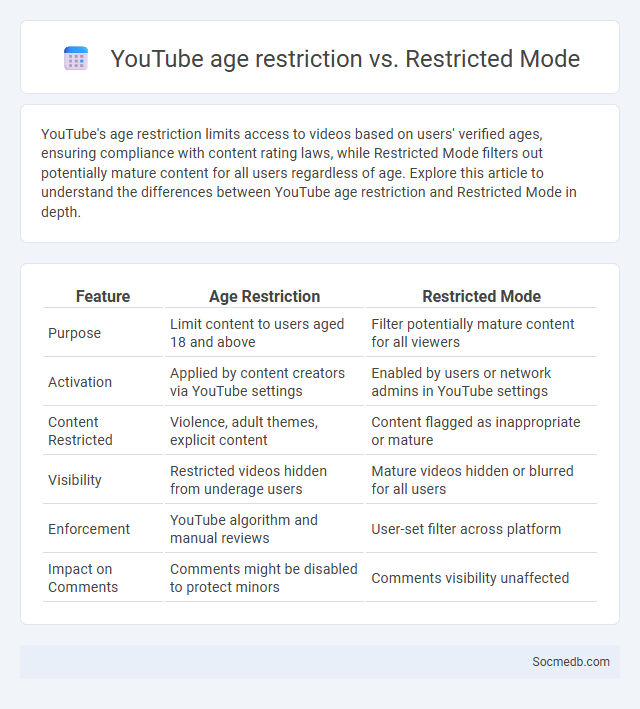
Photo illustration: YouTube age restriction vs restricted mode
YouTube's age restriction limits access to videos based on users' verified ages, ensuring compliance with content rating laws, while Restricted Mode filters out potentially mature content for all users regardless of age. Explore this article to understand the differences between YouTube age restriction and Restricted Mode in depth.
Table of Comparison
| Feature | Age Restriction | Restricted Mode |
|---|---|---|
| Purpose | Limit content to users aged 18 and above | Filter potentially mature content for all viewers |
| Activation | Applied by content creators via YouTube settings | Enabled by users or network admins in YouTube settings |
| Content Restricted | Violence, adult themes, explicit content | Content flagged as inappropriate or mature |
| Visibility | Restricted videos hidden from underage users | Mature videos hidden or blurred for all users |
| Enforcement | YouTube algorithm and manual reviews | User-set filter across platform |
| Impact on Comments | Comments might be disabled to protect minors | Comments visibility unaffected |
Understanding YouTube Age Restriction
YouTube age restriction limits access to content deemed appropriate only for viewers aged 18 and above, ensuring compliance with legal regulations and community guidelines. This feature uses account age data and user sign-ins to filter videos with mature themes, explicit language, or sensitive material. Content creators can also self-impose age limits to target adult audiences, enhancing user experience and platform safety.
What Is YouTube Restricted Mode?
YouTube Restricted Mode is a filter setting designed to limit access to potentially mature or inappropriate content, enhancing safety for younger users or those seeking a more controlled viewing experience. This feature uses community flagging, age restrictions, and other signals to identify and hide videos that may contain sensitive material. By enabling Restricted Mode, you can help ensure that your YouTube experience aligns with your preferences for content appropriateness.
Key Differences: Age Restriction vs Restricted Mode
Age restriction on social media platforms enforces a minimum user age, typically 13 or 18 years, to comply with legal regulations like COPPA or GDPR, preventing underage access to protect privacy and safety. Restricted Mode, available on platforms such as YouTube, filters out potentially mature or inappropriate content using automated algorithms and keyword detection, offering users or parents control over the viewing experience. Age restrictions focus on user eligibility, while Restricted Mode targets content visibility, creating distinct layers of protection for younger or sensitive audiences.
How Age Restrictions Work on YouTube
YouTube enforces age restrictions to comply with legal guidelines and protect younger audiences from inappropriate content. Videos flagged as suitable only for viewers aged 18 and older require users to sign in and verify their age before accessing them. Your experience is safeguarded by these measures, ensuring content remains appropriate for your age group while balancing creators' freedom to share diverse material.
Activating and Managing Restricted Mode
Restricted Mode on social media platforms helps filter out potentially mature or inappropriate content, creating a safer browsing environment. You can activate Restricted Mode through your account settings, customizing it to control the visibility of sensitive videos, comments, and posts. Managing this feature regularly ensures that your content experience aligns with your personal or family safety preferences.
Impacts of Age Restriction on Content Creators
Age restrictions on social media platforms significantly affect content creators by limiting their audience reach and engagement opportunities, particularly for creators targeting younger demographics. These restrictions often reduce monetization potential, as advertisers and platforms prioritize content accessible to broader age groups. Consequently, creators must strategically navigate platform policies to maintain visibility while complying with age-related content guidelines.
How Restricted Mode Affects Video Accessibility
Restricted Mode limits access to videos flagged for mature content or inappropriate material, reducing the visibility of such content across social media platforms. This feature uses automated filters and user settings to block videos that may contain sensitive or explicit themes, impacting the accessibility of a wide range of content for viewers seeking safer browsing experiences. Consequently, creators producing borderline content may see decreased reach and engagement due to these algorithmic restrictions.
Bypassing & Overriding Restrictions: Is It Possible?
Bypassing and overriding social media restrictions involve techniques such as using Virtual Private Networks (VPNs), proxy servers, and encrypted messaging to access blocked content or features. While these methods can be effective in circumventing geoblocks and censorship, platforms continuously update their algorithms and policies to detect and prevent unauthorized access. The dynamic nature of social media restrictions requires constant adaptation and awareness of legal implications in different jurisdictions.
Parental Controls: Which Option to Choose?
Choosing the right parental controls for social media depends on your child's age, online habits, and the platform used; Instagram, YouTube, and TikTok each offer unique features like content filters, screen time limits, and activity monitoring. Evaluate tools such as Google Family Link or Apple Screen Time for cross-platform management and real-time alerts to protect your child from inappropriate content and cyberbullying. Your decision should balance security and privacy while fostering healthy digital habits tailored to your family's needs.
Ensuring Compliance with YouTube’s Content Policies
Ensuring compliance with YouTube's content policies is crucial for maintaining your channel's reputation and avoiding penalties such as content removal or account suspension. You must regularly review YouTube's community guidelines, copyright rules, and advertiser-friendly content standards to align your videos accordingly. Consistently monitoring your content for originality, appropriate language, and adherence to these policies helps your channel grow sustainably and securely.
 socmedb.com
socmedb.com